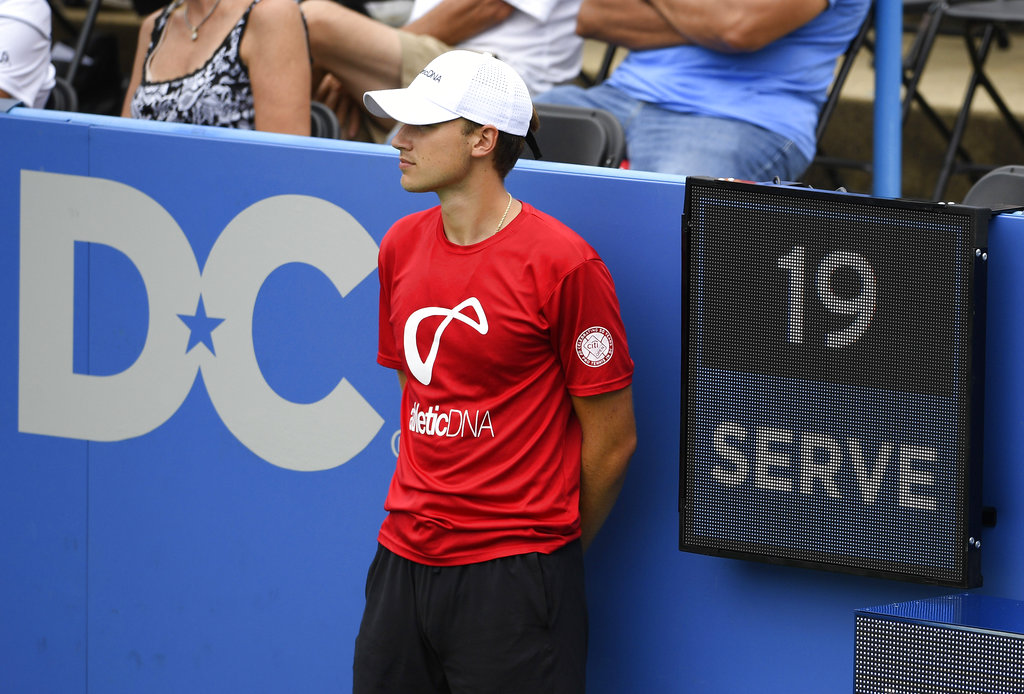
In this Friday, Aug. 3, 2018, photo, a ball boy stands next to the serve clock during a match between Kei Nishikori, of Japan, and Alexander Zverev, of Germany, at the Citi Open tennis tournament in Washington. (AP Photo/Nick Wass)
Any discussion of the serve clocks that will make their Grand Slam debut during the U.S. Open’s main draw starting Monday, and could become a regular part of tennis as soon as next year, inevitably turns to Rafael Nadal and Novak Djokovic.
They are two of the greatest players in history — and two of the slowest between points. For one thing, Djokovic’s incessant bouncing of the ball before a service toss delays things. So do Nadal’s habitual mannerisms: the touching of the nose, the tucking of the hair, the grabbing at the shorts, and on it goes.
And while neither was a big fan of introducing digital readouts on court to show the 25-second countdown before each first serve, the two men with a combined 30 Grand Slam singles titles seem ready to accept that they must abide by a change intended to add uniformity to their sport.
“I just need to go faster,” Nadal said, matter-of-factly.
Djokovic’s take: “I’m pretty comfortable with it.”
Both got a chance to see what this new, stricter world will look like during a test run at a handful of hard-court tuneup tournaments over the past month.
“Some of the guys might think this is targeted to them,” said Gayle Bradshaw, executive vice president for rules and competition on the men’s tour.
Referring to Nadal and Djokovic, specifically, Bradshaw added: “They’ll adjust. And I think for Rafa, it’s going to be a benefit: Him wearing down the other guy.”
The U.S. Tennis Association, ATP and WTA are tracking what competitors, spectators and TV broadcasters make of the new system. Reviews from players so far have mostly been positive or indifferent, although Serena Williams said she’s “not a fan of it at all.”
“You’re aware of it. You certainly look at it and notice it. I do think it’s a good thing,” said Andy Murray, a three-time major champion. “It’s one of those things in tennis that is so stupid: The players were sort of expected to sort of be counting to 25 in their head. … How are you supposed to know how much time you’re actually taking?”
Wimbledon semifinalist John Isner and others noted they would step to the line to serve and still have plenty of time — sometimes 10 seconds or more — left, enabling them to catch their breath or think about how to approach the next point.
“I didn’t feel rushed at all, by any means,” Isner said. “Maybe it can slow you down.”
That might have contributed to one unintended consequence during the three men’s tournaments where clocks were used for qualifying and main draws: longer matches. It’s a small sample size, and, of course, it’s dependent on the particulars of individual contests — nearly 30 percent more matches went to 7-5 or a tiebreaker in the third set in 2018 than 2017 at those events. But third sets lasted an average of 5 minutes longer this year than last year. First sets were nearly 1 1/2 minutes longer this year while second sets were a minute shorter.
Servers were warned 74 times and returners received nine warnings at the ATP and WTA tournaments with the clocks.
It’s possible this setup will become more widespread as soon as 2019; the ATP Board could consider that for the men’s tour during its U.S. Open meeting.
The amount of time taken between points has been a subject of discussion in tennis for quite a while now, just as other sports are concerned about whether events that take too long are losing viewers in this age of short attention spans and competition for eyeballs (take Major League Baseball’s limits on mound visits, time between innings and movement toward a pitch clock).
“This just makes it a little more transparent, a little more visible,” U.S. Open tournament director David Brewer said. “North American fans are used to shot clocks. They actually expect this sort of thing.”
There already was a time limit in tennis, but it was entirely up to a chair umpire’s discretion, because no one — most importantly players, but also folks in the stands and TV viewers — knew exactly how many seconds had elapsed. Now it will be apparent to everyone, much like a shot clock in the NBA and college basketball or a play clock in the NFL and college football.
The serve clocks — along with a strict 7-minute period from when players enter a court until a match begins, also shown on digital readouts — were tested during 2017 U.S. Open qualifying.
The basics of the serve clock: After announcing the score, chair umpires start the countdown (they have leeway to wait if a particularly long point merits an extra pause). If the 25 seconds expire before the service motion begins on a first serve, the server will receive a warning, then be assessed a fault for each subsequent violation (second serves are supposed to happen without delay, so clocks won’t be used). If the returner isn’t ready at the end of 25 seconds, first comes a warning, then the loss of a point with every other violation.
The basics of the pre-match period: Clocks will count a minute from when players step on court until the coin toss, 5 minutes for the warmup, then another minute until the opening point. Delays can result in fines of up to $20,000, according to USTA spokesman Chris Widmaier.
He said players already have been docked as much as $1,500 during recent tournaments.
“The intent is not to fine players. The intent is to get players used to this new procedure and also to truly build consistency,” Widmaier said, “so the matches start when they’re supposed to start for television and for fans.”

